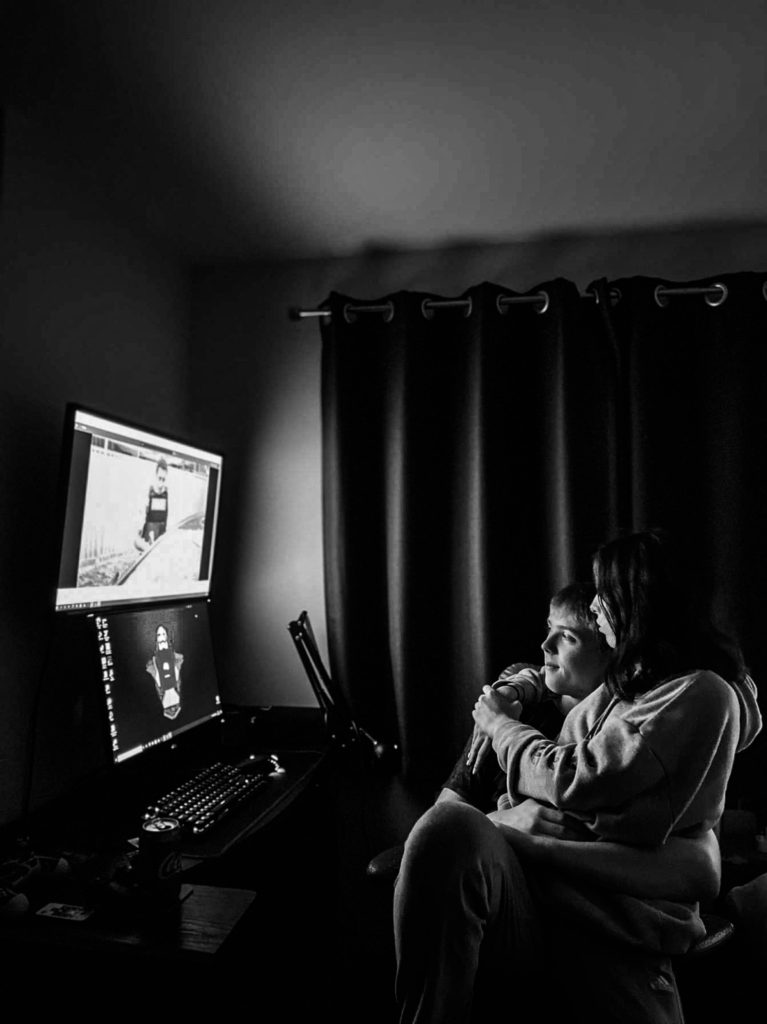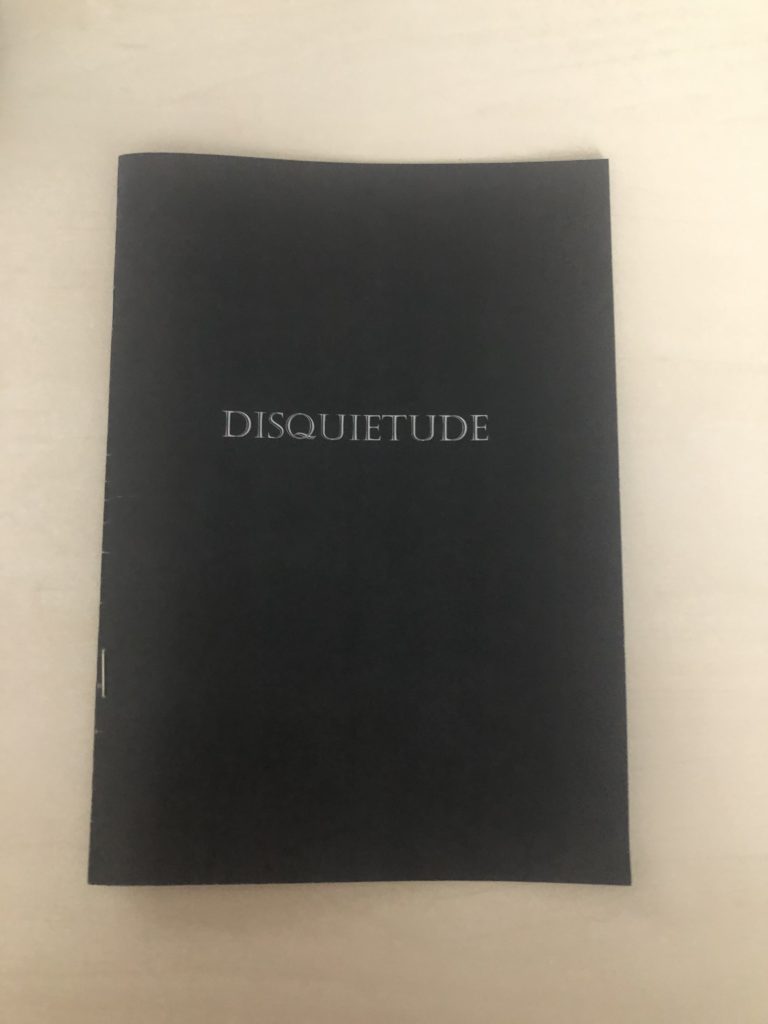All posts by Beth P
Filters
fILM eVALUATION (TO BE UPLOADED)
PLANNING:

Overall I felt as though my planning was quite thorough, especially when it came to the interview questions that I was asking my mum – that meant that i was really prepared and provided some great audio for me. One thing that I did struggle when it came to planning was the visuals for my film. I wanted the movie to be hard hitting although I knew it would be unethical and uncomfortable for my mum if I were to film her ‘being ill’ essentially. I pondered for a long time on what I wanted to actually film, and in the end I came up with most of my visuals on the spot as my planning in this area wasn’t too detailed. The ‘where’ part of my planning was easy – as it all took place in my home, however I also did end up getting some footage outside the house at the shop – highlighting that I came up with a lot of my visuals on the spot. Overall, I think my planning process was okay, I feel as though I should’ve been more thorough when it came to planning the actual footage since I found myself stuck for ideas a lot of the time – leading to some not so interesting or visually pleasing footage.
EXECUTION:
As I’ve mentioned, I struggled to come up with some interesting pieces of footage. I took a documentary style approach to my work, I began filming on a canon DSLR camera however I found this hard to use and inconvenient at times. This is because sometimes I would have to quickly get out my camera if I noticed my Mum was breathless, therefore it was easier to film a lot of the footage on my IPhone that I always had on me. However though, the filming process was an easy and enjoyable one and bought me closer to my mum to understanding her illness. One thing I did find difficult is making the footage aesthetically pleasing in some way or another. At times my visuals were not that clear and generally not that interesting. So, if I were to change anything it would be to figure out how to make a documentary style movie aesthetically pleasing. The execution of filming wasn’t a very time consuming process since each bit of footage was quite short, however coming up with visuals to match the audio was a tricky part.
EDITING:

Generally, editing was a really time consuming process. The audio was one of the most lengthy process as I had to listen to 10/15 minutes of footage a number of times and cut out the pieces that I wanted and the bits I didn’t want. I managed to slim the audio down to about 3 minutes and as you can imagine this took a lot of time, as I wanted the most important, hard-hitting bits of information in my film. Adding and editing the visuals was a fairly easy process, it was just a case of cutting out the bits that I didn’t want or need, bits that weren’t visually pleasing at all or bits that weren’t clear with bad framing. However, I did really well when it came to editing and I feel very confident when it comes to using Premiere.
Overall:
I am really pleased with how my film turned out. My favorite element of the film is the audio of my mum speaking, I feel as though she answered the questions really well and that is what made the film the most emotionally moving. One thing I would change about the movie is some of the footage, as mentioned before I wish I was able to express my mum’s illness a little bit better while still being aesthetic/visually pleasing however this was difficult to balance at times. However, it is one of my favorite final pieces that I have made and I’m glad I could show my understanding and empathy for my mother through a film.
Film Editing
After gathering my footage, I took to the software Premiere, a software that I have used previously, to put all of my footage together and edit it. Due to using this software in the past, I felt comfortable and at ease when using it and made my editing process that much easier.
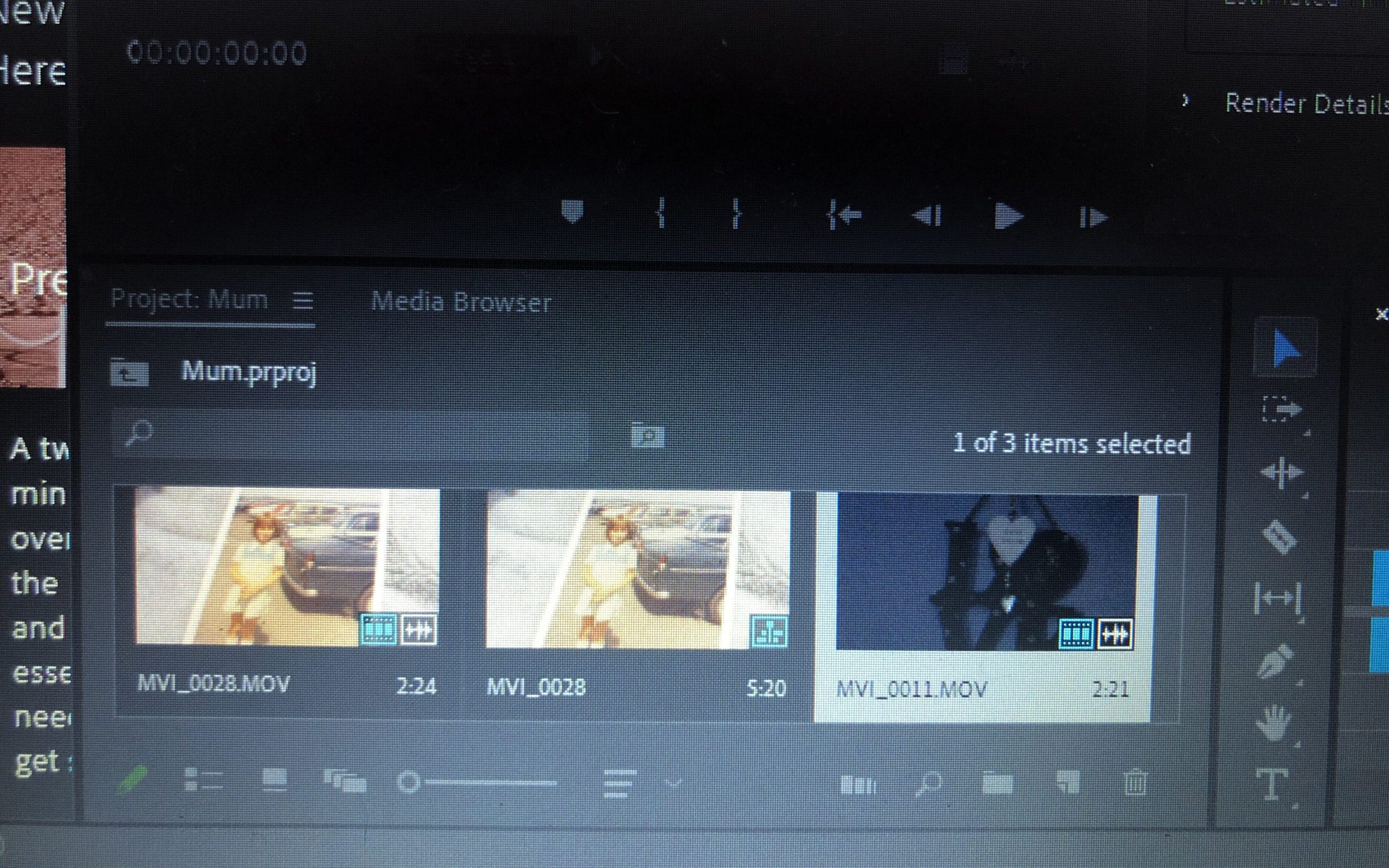
To begin with, I started by importing my footage intro Premiere. The screenshot above shows the library in which the footage sits in when editing. I normally import all of my footage (from my SD card) so that I can look through them all and select the footage that is most suitable and that I like the most.

After importing and selecting the footage that I like best, I then take the footage from the library and drag it into the bar shown above. This allows you to see how the video plays and also puts it into different sections such as V1 (video 1) and A1 (audio 1). This allows you to maneuver around the different sections of audio/video without any confusion. This bar is where all your sections of video and audio lies, creating your film.
When adding my footage to the bar, the audio will come with it and appear in the A1 section. To get rid of the background audio (because I will be adding a different audio over the top), I lock the V1 section and then delete the A1 section. Locking the V1 section will allow no footage to be deleted when I’m deleting the audio from it.
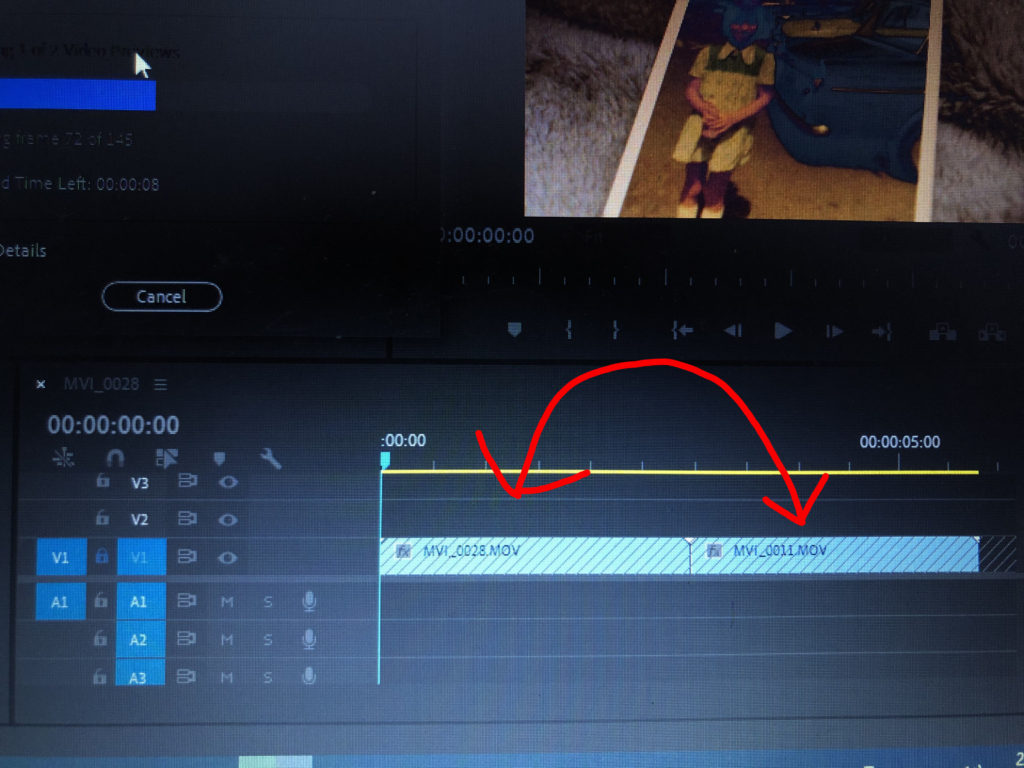
After uploading all of my footage that I am happy with, I then play around with the order of the videos. Sometimes certain videos don’t go well next to each other so I experiment by shifting the footage around to create a sequence that I am happy with. You can do this by unlocking the V1 area and simply dragging the different sections of footage to other areas. I feel as though experimentation is key to making a film or a photo book because you never know what you could create through experimentation, additionally you can point out the weaknesses of your film through this process. If I didn’t think that a piece of footage was suitable for my film anymore, I would simply delete it and insert another video that I feel would be more appropriate to my film.
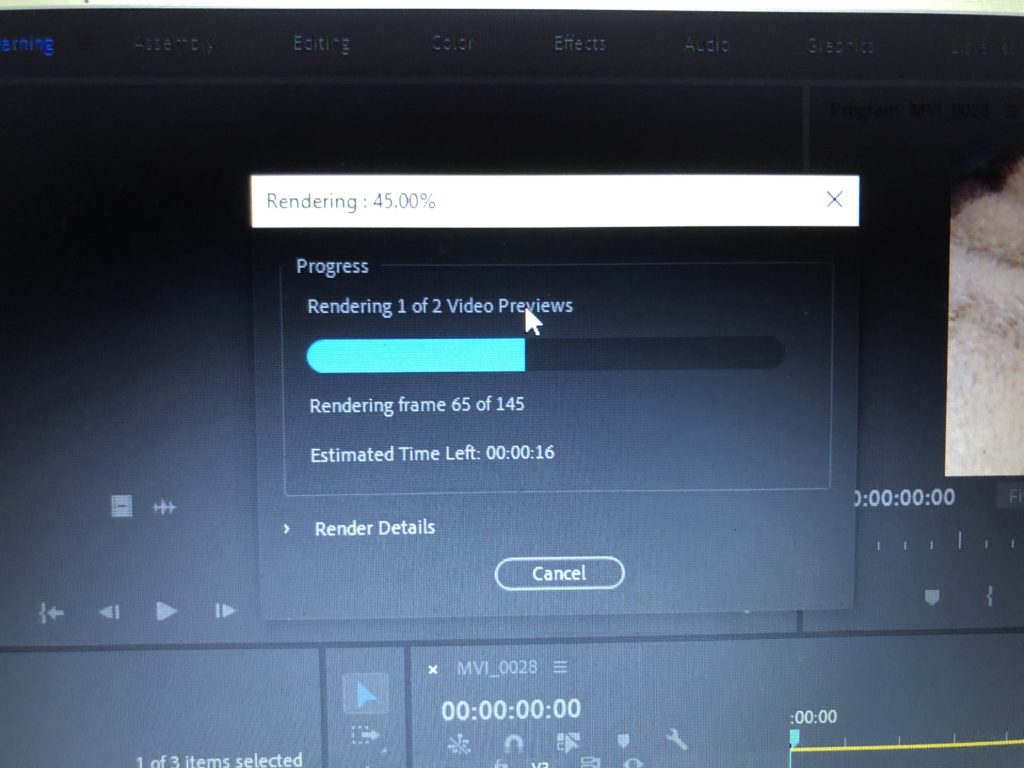
Also, after adding all of my footage, I would render my clips so that it ran smoothly and there were no sign of any glitches/jumps etc. This also allows the video to be exported easily and increases the quality of the video when it comes to exporting.
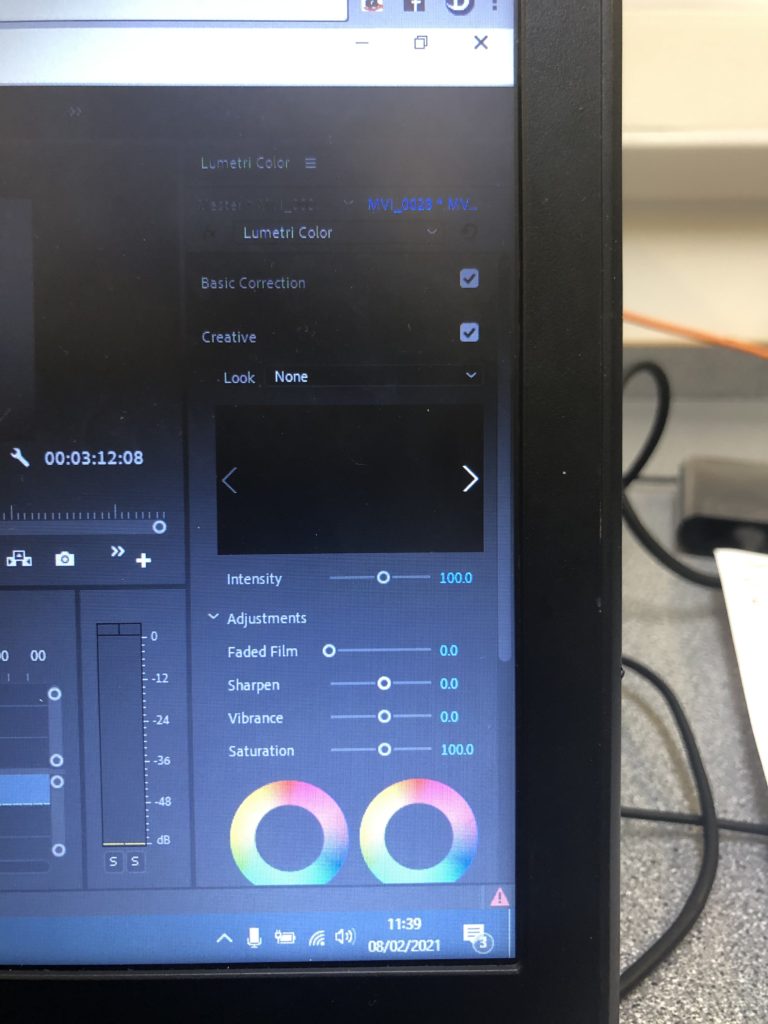
I wanted my film to be lacking in colour, with a lack of contrast etc to create a dull, sad and mundane atmosphere to my work. Therefore, I clicked the color tab at the top of the screen in the Premiere software and used the basic correction and the creative tab (as seen above). I experimented first with the saturation/vibrance/fade/brightness/exposure etc and eventually got to a colour that suited the overall vibe that I was looking for. The exposure varied in every clip depending on how dark it was, for example, if my clip was filmed in the dark I would increase the exposure more than usual. My saturation, sharpness and fade was all standardised however. In every clip I desaturated it to 51.9, I then increased the sharpness to 30.9 and then increased the fade of the clips to 42. I did this to every clip so that my whole film looked the same. When adding the effects, I made sure to also render the effects in and out so that again, there were no glitches and everything would run smoothly.
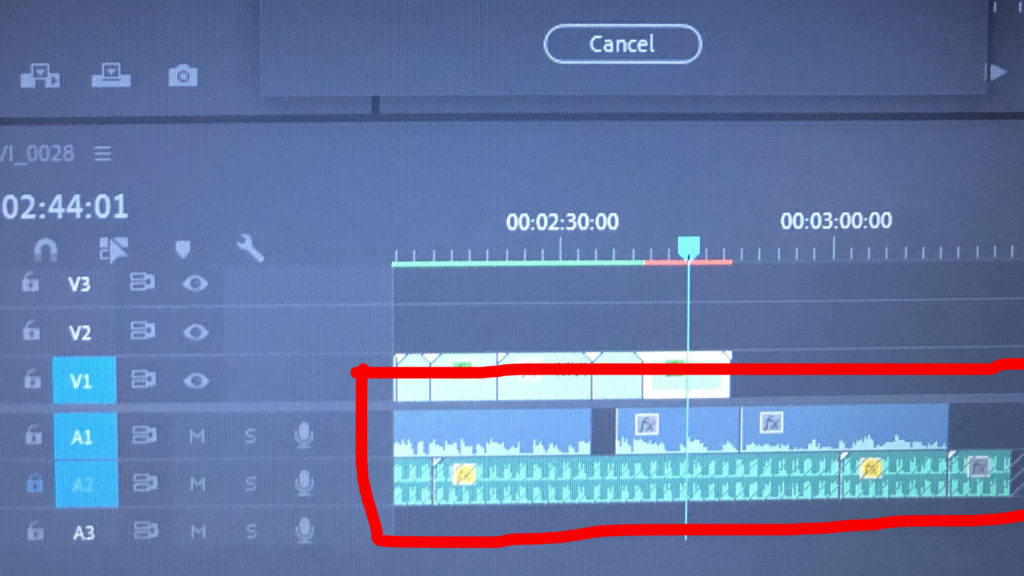
After I was happy with how my footage looked and ran, I then began focusing on my audio. My audio was filmed via video so that it would be easy to import, the importing process was the same as the videos. When adding my audio though, I made sure to lock my V1 so that no footage would be overlapped by the audio footage. After placing my audio in the A1 area, I then deleted the video footage so that the audio was the only thing left. I had around 10 minutes of audio so editing it was a long and time consuming process. I had to listen to the audio a various amount of times and cut out sections I thought were the most important.
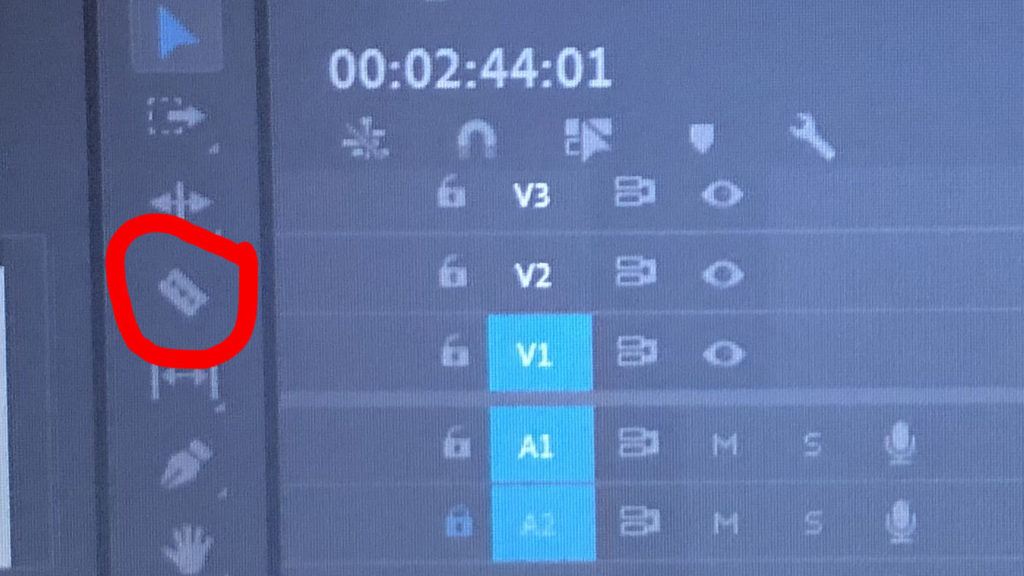
This tool was very helpful when it came to editing the audio. Since I had so much audio to listen to and edit, this cutting tool made it easy to quickly eliminate any sections of audio that I didn’t wish to keep. After chopping the audio and keeping the bits that I liked and that were relevant to the film, I was done with making my film. In addition to the audio of my Mum speaking, I also went to Sound.org – a website that provides a range of audios available to download. I felt as though some background noise was needed to provoke some emotion and to make the film more hard-hitting. So, I went to the website and found a slow heart beat sound, downloaded it and placed this into A2 (audio 2) – making sure to keep the video 1 and audio 1 locked just in case anything gets mixed up.
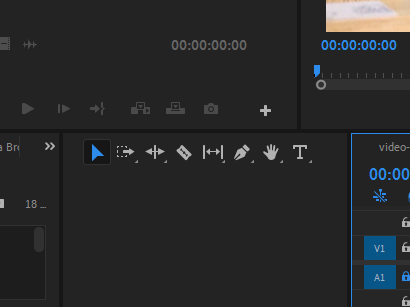
After all the video and audio editing was done, I wanted to make an outro that revealed the title of the video – ‘A Slow Progression’. I was looking at using the graphics that are available in premiere however nothing really grabbed my attention and there was nothing I really wanted. So, when the video became blank at the end, I selected the text tool (the ‘T’ above) and typed the title and placed it in the middle of the black screen creating an effect. I adjusted the text and size in the effect control panel.
Film Plan
WHO?
Since the concept is positioned around my mum, there will be scenes including her. However, due to ethical reasons I am not wanting to expose her too much and make her uncomfortable. I also don’t think it would be nice to expose her at her worst. I do want to reveal the struggles, however filming her having an exacerbation/attack would be quite unethical.
Therefore, I will only get a few shots of her. Some visuals I am thinking of are: her lying/sitting down on the sofa after a tough day (this is because the lounge is where she is most and will be an environmental shot), I may get some visuals of me and her shopping as I help her at the shop weekly due to the experience being too tough for her to do by herself. I would most probably like to get some shots of her tattoos, since this makes up the person that she is today, potentially her in her room, using her nebulizer, struggling to walk etc.
When getting some shots of her using her nebulizer or struggling to walk, I’m going to exclude her face as I feel like this may make her uncomfortable and may be over-exposing her which is what I don’t want since I want this to be a respectful and thoughtful piece of work. Thus, I will use medium/close up shots of her lower body that includes crucial subjects like the nebulizer for example.
I may also want to get some shots of my 14 year old sister, Mary doing some chores around the house. This is to show that my mum does need that extra help around the house as she struggles to do it by herself.
Additionally, referring to the prompt question below “What do you remember about being young?” I may want to include some archive images of my mum of when she was younger. This would add strong contrast within my film, showing what she looked and lived like before and what she looks and lives like now.
VOICEOVER
For my audio I’d like to insert an audio of my mum speaking about her illness. Therefore, I need to create a list of prompt questions in order to get the audio that I would like. I feel as though her telling her own story will add the hard-hitting aspect of my film.
The questions will be:
- What do you remember about being young? (Health wise)
- When did you begin to notice feeling unwell?
- How would you describe the feeling of your illness?
- What’s your worst memory about being ill?
- Are there any side effects to your illness?
- What do you struggle with the most?
- What is your biggest regret?
- What is the next step for you?
- What are some things you wish you were able to do?
This will most likely provide me with a lengthy audio to play with and edit and include upsetting but factual elements that happen in her life.
In addition to the voice over I’d also like to include some background noise just to fill in the gaps in the audio that may be apparent and to make the film also pleasant to listen to and not just to watch. I’m thinking that a slow heart beat sound may be a good background sound to represent hospitals, illness, getting through life etc and again to make the film more hard hitting.
WHAT?
Aside from clips of my mum I also want to include clips of my home and other elements that surround my mum and her illness.
I most definitely want to include her wide range of medications. This will provide me with a number of clips since she has too many to even count. I feel as though that this as well will be very striking to the viewers at how much medication she has to consume in order to keep her going. I would like to include clips of her bedroom as that is her place of rest and belongs to her and therefore connotes to her. I want to symbolise my mum in various ways as I feel like this adds some ambiguity to my film and allows the audience to think and also allows them to listen to the audio more closely since that is the main focus. Additionally, Id like to include different aesthetic visuals in my film just to add some interesting elements into the footage also. Things like shadows on the walls, windows, sunsets etc.
WHERE?
Most of the footage will take place in my home since my main visuals will be of my mum in the lounger, bedroom etc. This is where all her medication is also. Also because my mum rarely goes out due to the extreme anxiety she experiences when thinking about walking anywhere due to it being so difficult for her. Therefore, in order to keep her comfort and to keep the film as natureal as possible, most of the filming will be done at home.
However, I will also get some footage when at the shop and if we are ever out for a walk, to show how breathless she gets just from walking.
The voice over will also happen at home as this is where I can most likely get the most quiet area and to get a clear and thorough audio of my mum’s experiences. This also will increase my mum’s comfort and hopefully allow her to speak from her heart without any pressure.
HOW?
I will be filming on one of the Canon’s lended by school. In previous films I have made, I used my iPhone. However, due to the topic of this film and how important it is to me, I would like it to be in the best quality possible. But, if we are out and there is a something that strikes me as a quality piece of footage, I won’t hesitate to film it on my phone, making sure that it is in landscape so that it matches the layout of the other pieces of footage.
Before starting to film, I will gain the consent of my mum and my sister. This is because I may film them automatically while they’re doing their every-day things. Therefore, I don’t want to disturb them and then have an artificial piece of footage. I want my footage to be as natural as possible and therefore I will gain their consent and inform them that I may be filming them at various different times due to this photography project.
For my voice over, I will film the ‘interview’ on my camera. Then, I will upload the footage onto Premiere on my laptop, discard the visual footage and keep just the audio.
Final Essay
In What Way Have Richard Billingham and Matthew Finn Photographed People Who Are Close to Them?
“An inside position allows engagement, participation and privileged knowledge.” (Abigail-Solomon Godeau: Inside/Out)
In this essay I will be evaluating the different ways as to how Richard Billingham and Matthew Finn have photographed people that are close to them, in this case, their parents. My area of study in my personal project is documentary photography. This is a style of photography that provides a straightforward and accurate representation of people, places, objects and events. Specifically, I am looking into filmmaking using a documentary approach. I am positioning it around my mum, particularly, creating a documentary film in order to expose the hardships and complications that she faces on a day-to-day basis while struggling with a terminal illness – Stage 4 Emphysema. My overall aim of my project is to create a hard-hitting film that triggers powerful emotions for the viewer. Since I am also filming someone who is close to me, I feel as though looking into Billingham’s and Finn’s methods will add greater knowledge to my personal work and allow me to potentially take notes from the methods they have used when photographing their own parents. Billingham started off by taking images of his parents (with no prior experience) for reference so that he could paint them, as his main aim before photography was painting. His images of his parents then got noticed and became a huge success. The images exposed his tough life living in a tower block with his alcoholic Dad, Ray, and his overweight, temperamental mum, Liz. The exposure of his parents was intriguing to viewers and he eventually led on to create several documentary style films surrounding his parents. Matthew Finn took images of his Mother for over thirty years. His father did not live with him and he stated that his first intentions were not to create an archive of his mother, but to create stability, the photographing eventually became a habit. The more Finn discovered about his father, the more he wanted to protect his mum and be the person/man that would never let her down. The fact that his mother was wanted and needed to be in his photography, formed a strong bond between the two and she played a huge role in the making of the photographs. Years later, she developed dementia, and could no longer recognise Finn or herself even, thus, all he had left were these archival images.
Contextually, Abigail Solomon-Godeau published an essay, Inside / Out, that became incredibly successful. She discussed what she refers to as the inside/outside position of photographers in relation to their subjects. Referring to the opening quote above, she believes that an inside position (when you are close with your subjects and have a personal relationship with them) “allows engagement, participation and privileged knowledge” (Solomon-Godeau 1994: pg 2). It’s an intimate, trusting and engaging role for photographers and their subjects that often allows authenticity. She then goes on to say that an outside position can often be objectifying, distant and unsympathetic – since there is no personal relationship with their subjects and no ‘inside’ point of view.

Consider this image above taken by Diane Arbus of transvestites. She often depicted people who were seen as ’different’ at the time e.g., gay people/people with disabilities etc – Solomon-Godeau, in her essay, criticises the work of Arbus. Arbus specifically takes an outsider’s point of view to photography and has often been accused of basing her photography on ’distance and privilege’ rather than using her photographs for positive effect. She has often been described as having a ’guilty pleasure’ when it came to photographing people who were different and was accused of being voyeuristic in her approach. Thus, an inside perspective to photography can be known as the” good position” as an outside position can be very controversial and used for the wrong reasons. However, having an inside position also has its pros and cons. One con is that having an inside position can be very socially sensitive, and sometimes may be over personal, gritty and brutal. Due to Richard Billingham and Matthew Finn being very close to their subjects – their family members, they most definitely have an inside position to their work but are they using their positions for the right reasons and how is their position revealed through their work?
As mentioned earlier, Richard Billingham revealed his tough life with his unique family members, specifically his parents Liz and Ray. His photos and films were extremely intriguing as they were extremely high in ecological validity and gave us a truly real experience within his images – no set up composition, no plan, just simple, raw images that exposed his own life.

Take this photograph for example, within this one image, there’s a number of things that maybe other photographers wouldn’t see as visually pleasing: slouching, food stains, a generally messy frame, an obese Mum and a drunken Father. Billingham, quite clearly, takes an inside approach to his work, since the circumstances he depicts would only be seen privately in your own home. Billingham is one of the only people that would’ve had access to his parents in this way. This is what made his photos so unique and special, the lack of accessibility to these kinds of photos, showing a lower-class life and the events that occur within it are fascinating and hard-hitting. Billingham’s insider position is what brought his images to success. Due to his close relationship with his Dad, Billingham stated ’I don’t think he took any notice,’ [when filming] – this emphasises the rawness of Billingham’s images and films as no behaviour was exaggerated and all was an accurate representation of his life. Richard’s overall aim wasn’t to expose his parents in a negative light; therefore, he didn’t use his inside position to objectify or to distance himself. After all, his first intentions were to paint the images of his Mother and Father in the style of Post-Impressionist art. On the other hand, you could argue, that after realising that the images of his parents were the key to his success, he then continued to use them to his advantage in order to gain more attention. Similarly, he has been accused of over-exposing his parents, and that filming his parents in a vulnerable position was unethical. Like me, Billingham takes a documentary style approach to his images and films, he claimed, ’I didn’t want images of the tragedy of the situation. I wanted them to be emotionally very moving’ (Richard Billingham: Photoworks, 2007). This then, suggests that his insider position wasn’t used to expose/objectify his parents, but to create an emotional effect for his audience.

Matthew Finn, took pictures of his Mother for over 30 years, exposing the shift from middle-age to old-age. His work is described as a ’poignant body of work, filled with warmth yet conscious of the fragility of life’. Like Billingham, Matthew’s work also takes a documentary style to his work, representing an account of life, a deeply humanistic response to a set of human circumstances. Since this project with his Mother was so personal, Finn also clearly took an inside perspective when it came to photographing. There is no objectivity or distance within his photographs since one of his intentions were to create presence [of his mother] within his work. His images show the definition of an inside perspective, allowing ’engagement, participation and privileged knowledge’. He used this position for positive effect, since he gathered these images over a long period of time, and only published them when his Mother essentially disappeared due to the onset of dementia. The photographs are those of remembrance and respect, which demonstrates the advantages of an insider’s perspective; to look back on personal memories that the photographer and subject experienced in real life. His inside perspective also outlines other pros; he was able to photograph his Mother over a long period of time. This, as mentioned, showed the shift in her life and preserved her beauty. An outsider’s perspective wouldn’t have that kind of opportunity and makes Finn’s photographs interesting and raw. Additionally, due to his personal perspective, he was able to capture his Mother doing mundane, everyday tasks, which again isn’t accessible from an outsider’s perspective. His images provide the true bond and trust that Finn and his Mother, Jean have.
Comparatively, it is apparent that both photographers demonstrate an insider’s perspective when photographing their family members. Often, an inside perspective is criticised due to its over-exposure and social sensitivity. However, both photographers’ aims are clearly not to objectify their subjects. Billingham clearly wanted a factual and raw take to his work to create an emotional response to his audience, and had no intention at all to create negative connotations surrounding his Dad’s drinking etc. He stated, ‘I didn’t want to illustrate alcoholism or make a documentary about it’ (Richard Billingham: Photoworks, 2007). This again shows that he wasn’t using his perspective to expose his Father in any way and used his photography positively. Billingham also has stated that he had no specific aesthetic in mind when it came to visuals, and again just wanted footage that was 100% true to his life that he experiences. Matthew Finn had an extremely close bond with his Mother, especially after his Father left and secrets were revealed. Like Billingham, Finn had no intention of publishing the images that he had taken. Overall, however, his images show a very close, positive relationship between the two. Finn obviously had no negative intentions when it came to photographing his Mum, instead, his photos reflect great admiration and love for her. One difference between the two artists is, Billingham’s relationship with his parents seems somewhat distant. He has stated in the past that he hated growing up in a tower block with his parents. In some way, Billingham reveals the emotional turmoil that appears often in their flat. The behaviour seen in his images and documentaries, especially from his Father, often impact the audience so much because of how shocking it was. It is difficult to imaging the effect that, that environment had on Billingham. On the other hand, Finn’s images reflect love, memory and closeness with his Mother. Although the images were documentary style, he always seemed to capture his Mother in her best light, and the images have been softly adjusted, creating an atmosphere of admiration for the closest person in his life. In conclusion, the relationship to their subject’s is clearly very different.
In conclusion, my analysis of both artists’ perspectives has inspired the methods that I will use when filming my own Mum. Since Matthew Finn’s perspective is a little more personal and reflects the bond that the two had I will most likely be referring a little closer to his methods. I, overall aim to create a respectful, loving video for my Mother, showing my appreciation for her and my understanding of her illness. My perspective will evidently be from the inside, since I’m uncovering details of mine and my Mother’s personal life that only we have access to. However, Billingham’s documentary-style, film-making methods are what I will be looking to when it comes to visuals. I want to capture, raw, real-life footage of my Mum and the experiences we go through. This will be more hard-hitting for the audience, in my opinion. Unlike Billingham however, I’m not wanting to capture my Mum in a negative light, as this will essentially defeat the point of my project. I enjoy the fact that Finn created a large archive of his Mother before publishing the images. This inspires me to add older, archival images of my own Mum in order to reveal a ‘shift’ in her, going from healthy, happy and lively to ill, tired and struggling. Overall, an inside perspective allows me to have access to footage that no one else would and gives access to a wide range of information about my subject, thus forming an authentic, detailed movie that shows a close relationship between me and my Mother. My close relationship with my Mum and my inside perspective also allows me to have empathy with her whereas an outsiders perspective may be objectifying and may not show the true effects of her illness.
References:
https://www.nationalgeographic.com/photography/photo-tips/portrait-photography-tips/
https://www.theguardian.com/film/2019/feb/23/richard-billingham-ray-and-liz-interview
https://saatchigallery.com/artist/richard_billingham
https://photoworks.org.uk/richard-billingham/
https://www.getty.edu/publications/resources/virtuallibrary/0892363223.pdf
https://www.mattfinn.com/mother
https://www.photopedagogy.com/insideout.html
https://www.photopedagogy.com/uploads/5/0/0/9/50097419/week_5_abigail_solomon-godeau_inside_out.pdf
https://www.theguardian.com/artanddesign/2011/jul/26/diane-arbus-photography-sideshow
Film Analysis
Richard Billingham – Fishtank (1998)
Since throughout my project I have been closely referring to Richard Billingham and his documentary approach to photography, I feel as though it is most suited to deconstruct one of his films. Billingham’s intention is close to mine, I am planning on making a film of my Mother and he has closely photographed and filmed his parents for many years. Thus, I feel as though this deconstruction is particularly relevant to me.
Billingham takes a strong documentary approach to where he simply films his parents going about their every day lives. His Father is an alcoholic who often demonstrates peculiar behaviors (Ray) and his Mum (Liz) is an overweight, temperamental women. Although, Ray seems to be the main character throughout. In the beginning, there was no particular intention to photographing his parents, apart from using the images for references when painting them. However, when the images became a success, he continued to photograph them, and then began experimenting with film.
Here is a link:
Deconstruction
Immediately, when watching the clip, I find myself very uncomfortable as the scenes are very raw and real, almost as if I am there with Billingham and his parents. The scenes take place in their home; in the kitchen and in the lounge mainly. The camera angles vary, from being very close up to his parents’ faces to quite far away and including a shot of their home, which then adds to the atmosphere and essentially, ‘sets the scene’. Billingham often enjoys zooming in to a large scale, almost as if he is experimenting with his camera and seeing what works best. I’ve noticed in particular that he enjoys getting close ups of his father’s face and his father acting in his general, over exaggerated, humorous manner. There is most likely no editing that goes into Billingham’s ‘FishTank’ series since the scenes are quite messy, unplanned and not very visually pleasing. However, this doesn’t make the documentary ‘bad’ in fact it makes it that bit more intriguing. The main character in the series is clearly his Dad, most scenes are of him drinking and generally being rowdy. But his mother and brother are also included in the scenes. His scenes capture a range of different events in his home including; drinking, play fighting, smoking, his mother putting on makeup, arguing between his parents, the TV etc. He also tends to use the real-life sounds that come with his videos. There’s no editing with the audio and no sound-scaping or overlaps. This intensifies the documentary feel to his videos and again creates the feeling that you are there with them while watching. You also find him speaking behind the camera, which I find interesting and gives you his point of view of the situation, through audio rather than camera. The general colouring and toning of his footage is also completely natural, no editing there, however the lighting is mainly created by the artificial lights that are in the house. Technically, the camera he uses is clearly quite old (it was filmed in 1998 and he was able to get hold of a small hand-held camera) which again adds to the atmosphere and emphasizes that documentary feel. Billingham has stated previously that he didn’t want to focus on visuals too much and wanted to make the footage moving rather than aesthetic, which explains the lack of editing and composition.
Theory
Focus: The moving of the lens elements until the sharpest possible image is achieved. Depending on the distance of the subject from the camera, the focusing elements have to be set a certain distance from the camera’s sensor to form a clear image. A typical auto focus sensor uses a charge-coupled device (CCD).
Billingham tends to experiment with focus quite a lot within his Fishtank documentaries, this usually can be seen when he zooms in closely to his father’s face. His camera tends to de-focus with the fast paced movement with the zoom, then Billingham readjusts the focus so that the footage of his dad is clear.
Depth Of Field: For many cameras, depth of field (DOF) is the distance between the nearest and the farthest objects that are in acceptably sharp focus in an image.
Billingham tends to have a short depth of field. It is clear that he is very up close and personal within his methods. As mentioned, he likes to focus his camera very closely on things, and enjoys zooming in closely. Emphasizing his short depth of field.
Angles:


I’d say that Billingham doesn’t use a specific angle method as he is simply holding his camera and filming what is in front of him. However, out of all the angles within photography, I would say that he mostly uses the bulls eye composition method where the subject is pretty much smack bang in the center. This can often be seen when he his filming his dad in particular. He also tends to use canted angles which is where the camera is slightly tilted however I don’t think this is purposeful.
Movements:
Different movements in photography consist of; tracking, pannin, craning, titling, Steadicam etc. However, these are more high-end, technical filming techniques that usually come with larger cameras.

Billingham uses a hand-held approach. His camera was a hand-held one at the time when he was filming Fishtank which often came with shaky, real-life visuals. This increased his documentary style and made it feel as though we were there with him at the time.
Shot Sizes:




Billingham tends to use these shots when filming. He also uses establishing shots that show the scenes of his house however when filming his parents he tends to use these specific shots above. He uses the close up, big close up and extreme close up mainly on his father in the video I linked above.
Editing:
As mentioned earlier, Billingham didn’t tend to edit his footage too much as he wanted it to be as raw as possible. The editing method he is most close to using is Continuity Editing. Continuity editing is the process in film and video creation where you combine related shots, or different components of a single shot, into a sequence which directs the audience’s attention to the consistency of story across time and location.
Continuity editing aims to create a sense of realism or ‘believability’ which essentially is Billingham’s aim in his documentaries.
I will most likely be using this method of editing in order to create a realist experience within my work and to increase the documentary style.
Essay Plan
Essay Question
In What Way Have Richard Billingham and Matthew Finn Photographed People Who Are Close To Them?
General Plan
Opening quote: “An inside position allows engagement, participation and privileged knowledge.” (Abigail-Solomon Godeau: Inside/Out)
Essay question: In What Way Have Richard Billingham and Matthew Finn Photographed People Who Are Close to Them?
Introduction (250-500 words): What is your area study? Which artists will you be analysing and why? How will you be responding to their work and essay question? For my introduction I will describe what my area of study is – film-making/documentary photography and describe what my personal project is about overall and my aim. I will then state my two artists (Richard Billingham and Matthew Finn) and give an overall description of what their work is about. This will allow the reader the reader to fully understand who I am talking about and why they are specifically relevant to my work.
Paragraph 1 (500 words): Historical/ theoretical context within art, photography and visual culture relevant to your area of study. Make links to art movements/ isms and some of the methods employed by critics and historian. Here, although I have studied Post-Impressionism as my ‘ism’, I will be referring to Abigail-Solomon Godeau. She looks at the inside/outside perspective when it comes to photography . I feel as though this is more relevant to my body of work as opposed to post-impressionism, however this will be mentioned somewhere. I’ll be doing an overall description of what she talks about in her own essay and also include Harvard Referencing in order to boost the potential marks I could get. I’ll also describe Diane Arbus and include an image of her work in order to give a fuller description of the topic, inside/outside. She was criticised for her ‘outsider’ work and accused of objectifying the people that she photographed.
Paragraph 2 (500 words): Analyse first artist/photographer in relation to your essay question. Present and evaluate your own images and responses. The first photographer I will go into analysing is Richard Billingham. I may quickly go over what he does as a photographer and then go in to analyse one of his images (and include an image that he took for illustration). I’ll then go into analysing his perspective when it comes to photographing/film making (which is an insiders perspective). Additionally, I want to go into a second opinion, for example, I could say that he uses his photography for positive effect however his images/photographs aren’t exactly positive and may be objectifying in some sense. Also, I need to include different quotes that back up my argument for Billingham coming from an ‘inside’ perspective, thus, I need to look at specific interviews.
Paragraph 3 (500 words): Analyse second artist/photographer in relation to your essay question. Present and evaluate your own images and responses. Secondly, I will look into Matthew Finn. As before, I will quickly re-describe his area of work and what he does. And then I will reflect on his in side perspective. Again, I will also use quotes to back up my ideas. I will also add in one of his images to add illustration.
Conclusion (500 words): Draw parallels, explore differences/ similarities between artists/photographers and that of your own work that you have produced. In my conclusion I will compare the two artist’s in their methods. For example, Matthew Finn takes a softer approach to his work while on the other hand, Richard Billingham is much more upfront and raw within his work. I also want to link their work with my own and suggest ways they have inspired me in my own techniques. For example, I thoroughly enjoy Richard Billingham’s, up close and personal filming and Matthew Finn’s soft, admirable approach.
Introduction Draft:
In What Way Have Richard Billingham and Matthew Finn Photographed People Who Are Close To Them?
“An inside position allows engagement, participation and privileged knowledge.” (Abigail-Solomon Godeau: Inside/Out)
In this essay I will be evaluating the different ways as to how Richard Billingham and Matthew Finn have photographed/filmed people that are close to them, in this case, their parents. My area of study in my personal project is documentary photography. This is a style of photography that provides a straightforward and accurate representation of people, places, objects and events. Specifically, I am looking into filmmaking, taking a documentary approach to it. I am surrounding it around my Mum, particularly, creating a documentary film in order to expose the struggles and complications that she faces on a day-to-day basis while struggling with a terminal illness – Stage 4 Emphysema. My overall aim of my project is to create a hard-hitting film that triggers hard hitting emotions for the viewer. Since I am also filming someone who is close to me, I feel as though looking into Billingham’s and Finn’s methods will add greater knowledge to my personal work and allow me to potentially take notes from the methods they have used when photographing their own parents. Billingham started off by taking images of his parents (with no prior experience) for reference so that he could paint them, as his main aim before photography was painting. His images of his parents then got noticed and became a huge success. The images exposed his tough life living in a tower block with his alcoholic Dad, Ray, and his overweight, temperamental Mum, Liz. The exposure of his parents was intriguing to viewers and he eventually led on to create several documentary style films surrounding his parents. Matthew Finn, for over thirty years, took images of his Mother. His father did not live with him and he stated that his first intentions were not to create an archive of his Mother, but to create stability, the photographing eventually became a habit. The more Finn discovered about his father, the more he wanted to protect his Mum and be the person/man that would never let her down. The fact that his Mother was wanted and needed to be in his photography, formed a strong bond between the two and she played a huge role in the taking of the photographs. Years later, she developed dementia, and could no longer recognise Finn or herself even, thus, all he had left were these archival images.
Bibliography:
https://www.nationalgeographic.com/photography/photo-tips/portrait-photography-tips/
https://www.theguardian.com/film/2019/feb/23/richard-billingham-ray-and-liz-interview
“I don’t think he took any notice,” Billingham says. “Or if he did it was probably that he was pleased I was in the room with him. The camera acted as a mediator.” – Richard Billingham
https://saatchigallery.com/artist/richard_billingham
https://photoworks.org.uk/richard-billingham/
https://www.getty.edu/publications/resources/virtuallibrary/0892363223.pdf
https://www.mattfinn.com/mother
https://www.photopedagogy.com/insideout.html
https://www.photopedagogy.com/uploads/5/0/0/9/50097419/week_5_abigail_solomon-godeau_inside_out.pdf
https://www.theguardian.com/artanddesign/2011/jul/26/diane-arbus-photography-sideshow
Theory: Art Movements/Isms
Post Impressionism

After researching Richard Billingham as part of my artist references, I discovered that hiss first initial love for art was inspired by Van Gogh whose paintings involved every day life. He enjoyed how certain post-impressionist painters could situate the figure of a person in an interior really well – as if they are part of the interior themselves. Since I am referring mainly to Billingham, I feel it is best to explore Post-Impressionism to see how it inspired the art that he created.

Post-Impressionism is a predominantly French Art Movement that developed roughly between 1886 and 1905. It emerged as a reaction against Impressionists’ concern for the naturalistic depiction of light and colour. This movement tends to to emphasise broad qualities or symbolic content. Post-Impressionists, especially Vincent Van Gogh extented Impressionism while rejecting its limitations – they continued to use vivid colours, often a thick application of paint, and real-life subject matter. However they were more inclined to emphasise geometric forms, distort form for expressive effect and use unnatural or arbitrary colour.
The Post-Impressionists were dissatisfied with the triviality (lack of seriousness) of subject matter and loss of structure in most Impressionist paintings. Paul Cezanne, especially set out to restore a sense of order and structure to paintings in order to “make of Impressionism something solid and durable, like the art of the museums”. He achieved this by reducing objects to their basic shapes while retaining the saturated colours of impressionism.
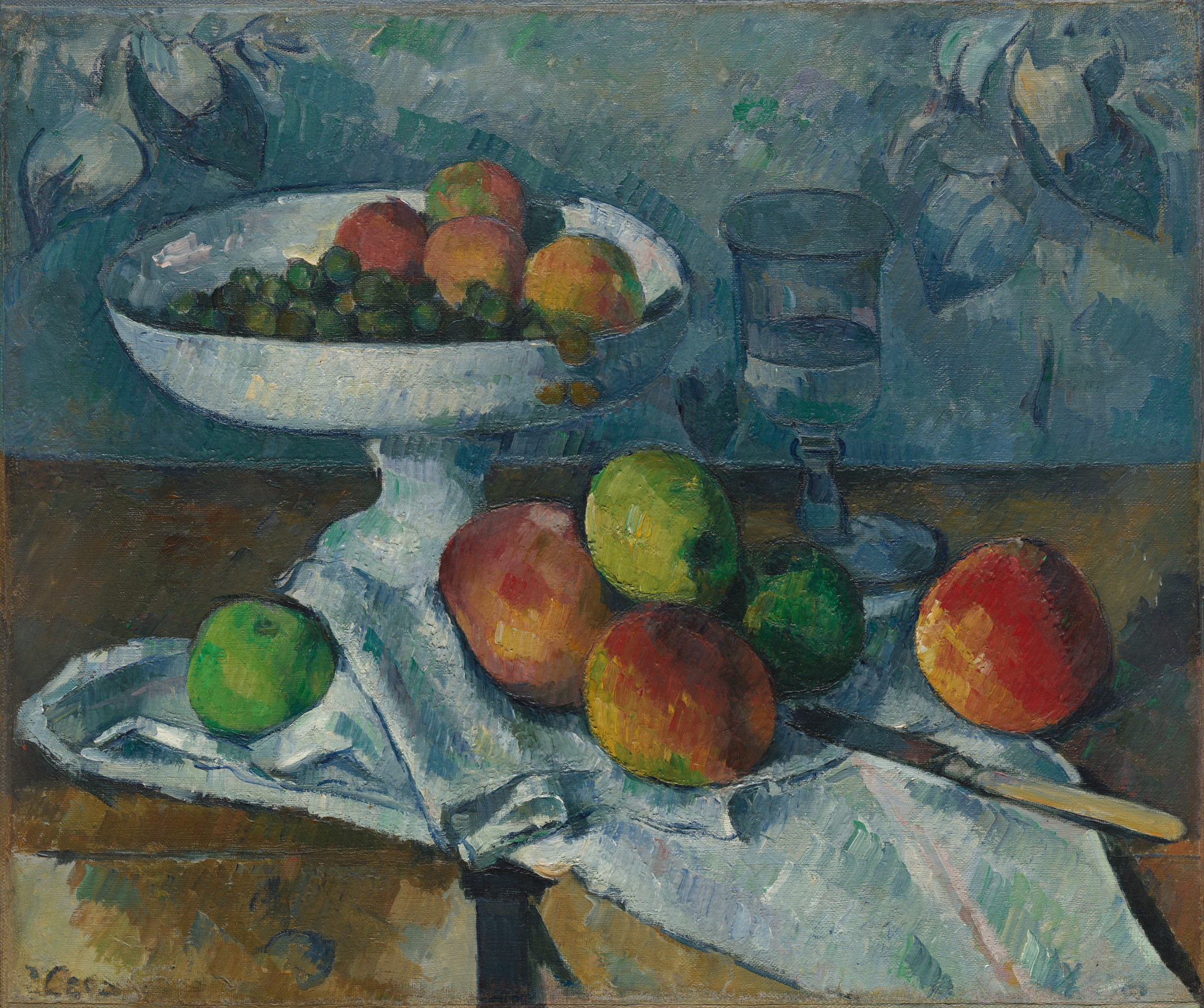
Artists that are included in this movement are: Paul Cezanne, Odilon Redon, Henri Rousseau, Paul Gauguin, Vincent Van Gogh, Charles Angrand, Henri-Edmond Cross, Maximilien Luce, Georges Seurat etc.
Post-Impressionism can be described as ‘a window to the artist’s mind and soul’. This is relevent to my personal study as my film is looking into my life, living with a poorly family member. My film will be similar to Post-Impressionism in the fact that my emotions and thoughts will be displayed throughout the moving images. Symbolic and highly personal meanings were displayed throughout this ‘ism’, Van Gogh especially looked to his memories and emotions in order to deeply connect with the world around them instead of simply depicting the natural world that surrounded him.
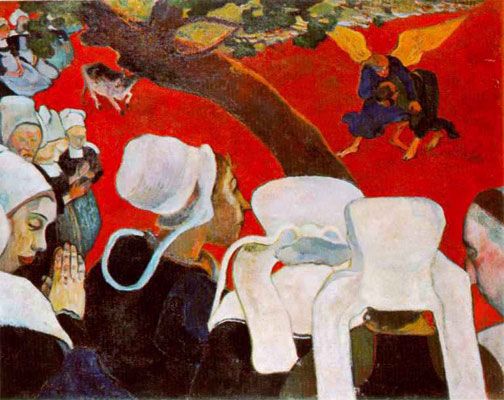
Consider this painting by Paul Gauguin who studied in the North of France where the unique history and customs represented a degree of spiritual freedom and primitive candor for Gauguin.
This painting depicts a revelatory vision of ‘Jacob’ wrestling with an angel, clearly delineates reality and spiritual manifestation through aesthetic form. While the ground of churchgoers who experience the vision is in the foreground, the Biblical struggle appears in the background, surrounded by a two-dimensional, brightly coloured plane. Gauguin relied upon the abstraction of the red ground to communicate the space of the vision as well as heightened emotions present at a religious revelation. As this work demonstrates, Gauguin rejected the conventions of industrialised modern society, in both his art and his life, through romanticised evocations of the primitive, the incorporeal, and the mystical. At first glance, it may not appear to be the most aesthetically pleasing image. However, as I was saying in my artist research on Richard Billingham, sometimes it is not about the aesthetic nature of a photo or a film but yet the meaning that are being conveyed behind the footage or image.
QUOTES
“I refused to board the Impressionist ship because I found the ceiling too low. . . . Real parasites of the object, [the Impressionists] cultivated art solely on the visual field, and in a way closed it off from what goes beyond that and what can give the humblest sketches, even the shadows, the light of spirituality. I mean a kind of emanation that takes hold of our spirit and escapes all analysis.”
Artist Odilon Redon, To Myself: Notes on Life, Art and Artists, trans. Mira Jacob and Jeanne L. Wasserman (New York: George Brazillier, 1986), 110
“Claude Monet’s landscapes are . . . the extremely sensitive shapes of our thoughts.”
—Critic Octave Mirbeau, “Claude Monet,” L’Art dans les Deux Mondes, March 7, 1891, reprinted in Mirbeau, Combats esthétiques, 430–431.
“It is no easier to explain Cézanne’s [fame] than to explain the man himself.”
—Artist Maurice Denis, “Cézanne,” L’Occident, September 1907, reprinted in Maurice Denis, Le ciel et l’Arcadie, ed. Jean-Paul Bouillon (Paris: Hermann, 1993), 129ff.
“I arrange lines and colors so as to obtain symphonies, harmonies that do not represent a thing that is real, in the vulgar sense of the word, and do not directly express any idea, but are supposed to make you think the way music is supposed to make you think, unaided by ideas or images, simply through the mysterious affinities that exist between our brains and such arrangements of colors and lines.”
—Artist Paul Gauguin, in Eugène Tardieu, “Interview with Paul Gauguin,” L’Echo de Paris, May 13, 1895, reprinted in Guérin, Paul Gauguin, 109
“However sad the chosen subject might be, however dreary the picturesque element that compose it, the painting will never . . . give the impression of sadness if the dominant characteristics of the lines, colors, and tone do not agree visually with the feelings the artist is seeking to express.”
—Artist Maurice Denis, “L’époque du symbolisme,” Gazette dea Beaux-Arts, March 1934, reprinted in Denis, Le ciel et l’Arcadie, 176–177
Artist references
Richard Billingham
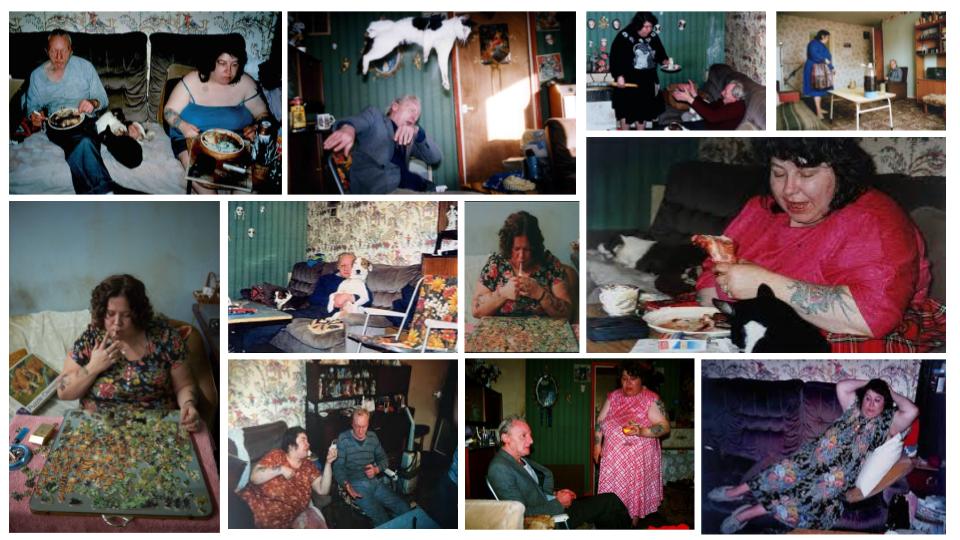
I chose Richard Billingham as one of my artists because his ideas and methods are similar to what I want to do; filming, almost exposing the inside life of my own family. He takes a documentary approach to his work which is what I’d like to achieve. His work also fits into the theme of Rebellion – since his Father was an alcoholic and his Mother was an angry lady with heavy tattoos, however this wasn’t exactly intentional.
He is an English Photographer, artist, filmmaker and art teacher. He is best known for his photography book (Ray’s A Laugh 1996), which documents the life of his alcoholic father, Ray and his obese, heavily tattooed mother, Liz. He’s also made a number of short films for example Fish tank (1998), which again surrounds his parents and exposes what goes on behind the scenes. He then went on to release his first feature film, Ray and Liz (2018). His work originally sprouted from when he aspired to be a painter, and was originally using the images he took as guidelines for his paintings, however, a tutor at Billingham’s art degree course fell upon these images and thought they were different and unique.
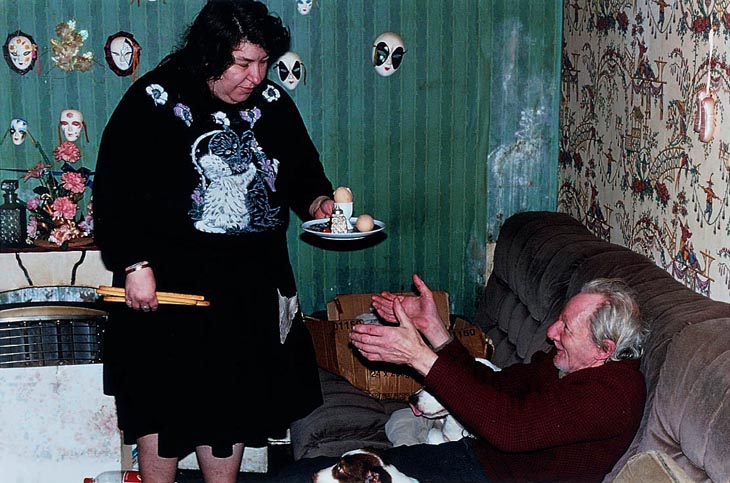
Billingham stated “I realised that if I photograph the whole room on a wide angle lens, you’re showing people everything, whereas if you focus on details then the viewer pieces together what that room looks like. It’s much more engaging – the viewer has to work to fill in the gaps, so I think it can be more engaging that way.” – This gives me some inspiration for the visuals of my film, instead of focusing on a big picture, grab details and smaller aspects of an area to intrigue the viewer. Here are a couple of interview based articles with Billingham:
https://thequietus.com/articles/26164-ray-liz-richard-billingham-interview
https://www.theguardian.com/film/2019/feb/23/richard-billingham-ray-and-liz-interview
PHOTO ANALYSIS
TECHNICAL: Looking at the image above, it is clear that Billingham uses natural lighting, nothing has been set up in order to achieve a specific type of lighting. However it does appear that there is a fluorescent/artificial lighting involved, most probably from the flash on the disposable camera that he used to take the photographs. In his films, he also appears to use natural lighting and no type of flash or artificial lighting has been used in order to achieve a certain type of lighting. Since he was using a disposable camera, the average shutter speed is about 1/100, allowing not much light in, however again, there is a flash. Disposable cameras also have a fixed mode of operation concerning the lens focus, aperture and shutter speed).
VISUAL: No filters or colour adjustments were used within Billingham’s images. Therefore, the colours in his images are natural and true to real life. The tones of his images are overall quite dark, especially when the pictures were taken during the night, however the tone does lighten when the images are taken during daytime. There is no specific composition when it comes to his photographs, as I have mentioned he takes a documentary approach to his work therefore there is no set up and takes images as things are happening right in front of him. This is the same for his films, there is no set up or composition, he simply let’s things flow naturally.
CONTEXTUAL AND CONCEPTUAL: As mentioned, Billingham wasn’t immediately set out to be a photographer, but instead, an artist. However when his tutor saw the photographs he realised that they were intriguing and had potential. His images and films were a portrayal of the poverty and deprivation in which he grew up in Cradley Heath, a town in Birmingham.

The area appears to be quite run down, middle to lower class area. He documented his parents mostly. His Mother being an overweight, tattooed chain smoker and his father being an alcoholic. His upbringing then may have been quite unique and different, compared to others he may have knew with ‘normal’ parents that lived without any addictions etc and lived within the middle to upper class areas. He may have felt many personal struggles when it came to his upbringing and expressed this through photography. Billingham has stated that he ‘just hated growing up in that tower block’. The reason why his images became so popular was because his pictures were surreal, claustrophobic and gave meaning to the idea of “too close to home”. It is not often you get to see someone essentially exposing their every day life and what the go through and have to deal with. As humans we have this inquisitive nature and wonder what happens behind closed doors. After making images, and them having a successful response, Billingham went on to make short films such as Fishtank and eventually a feature film named Ray & Liz. Overall going through major events that happened in his own life such as, when he was 10 years old and the family problems spiraled after Ray lost his job as a factory machinist.
It has been said that Billingham is protective and dismissive of the impacts that his childhood and upbringing has had on him. Instead of processing the hard times, he frames it – and out of that he did get successful, however he has said that “Jason often says to me now that, statistically, we should either be in prison, or dead.”. Richard Billingham most definitely turned a bad thing into a good thing. Which is the place that I am coming from when it comes to making my movie. My Mum does suffer from a terminal illness and things do get hard sometimes however exposing the inside to my life may bring some realization to some people and remind people that everyone has things going on behind closed doors.
Here’s a link to one of Billigham’s epiosode’s of ‘Fishtank’:
Meaning and Methods
Since I am making a film, I would like to focus on Billinghams’s filmmaking when it comes to talking about his meaning and methods. In the second clip I’ve inserted he says that the images he took ‘just happened by themselves’ and he wanted to experiment and see how things would look if he filmed the situations that he was living through. He wanted to explore a new medium to see if the same ‘magic’ would happen that appeared in his photographs. He also stated that with videos, he was looking for a ‘good catch’ and that he wanted to portray the emotions that were being expressed through a video.
He filmed most of his videos on a hand held camera and simply documented what he saw. His focus wasn’t necessarily on techniques but on capturing certain moments in order to create a hard hitting, close to home film. This is what’s good about documentary photography, it’s often non-fictional and true to real life which makes it somewhat more intriguing. He considers his photography ‘accidental artwork’ as he didn’t intend from the start to even be a photographer, but an artist. Billingham goes on to state in the interview that I have linked below that he didn’t want a polished aesthetic – he just wanted to make his images and films very moving emotionally.
Richard Billingham | Photoworks
From all the research it is clear that Richard Billingham’s meanings and methods are similar to what I would like to achieve. I’m not looking to make a technical, studio film, I’m wanting to make a hard-hitting, true to real life documentary film that captures certain struggles in my life, specifically surrounding my Mum, just as Billingham did with his parents. He has definitely inspired me with his short films and it goes to show that things don’t necessarily have to be the most visually pleasing or have a direct story for them to be a success.
Laia Abril
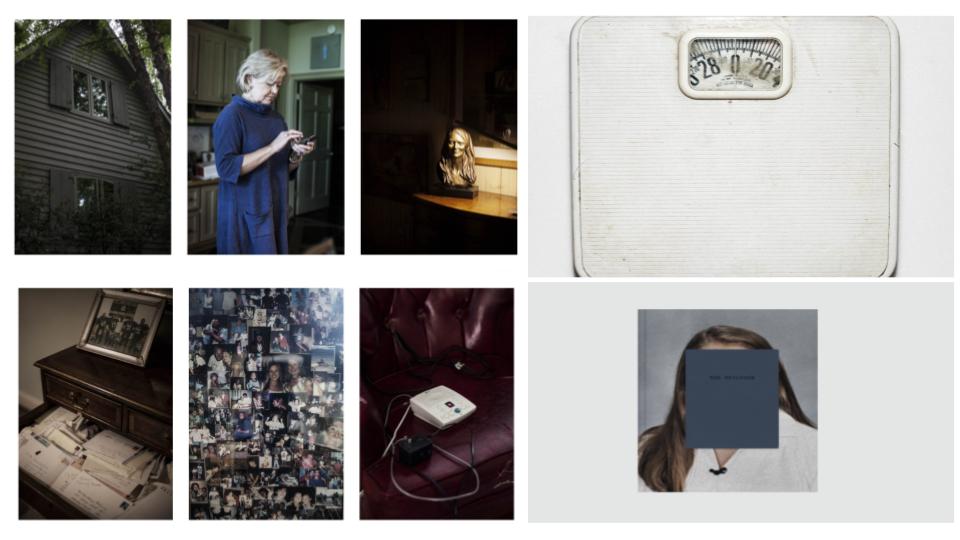
Laia Abril is a research-based artist working with photography, text, video and sound. She typically enjoys telling intimate stories that raise uneasy and hidden realities related with sexuality, eating disorders and gender equality. The Epilogue is a story of the Robinson Family and the aftermath in losing their 26 year old daughter to bulimia. She worked closely with the Robinson family and and reconstructed Cammy’s life through memories and flashbacks shown through the family’s grieving process. The Epilogue is about Cammy’s absence as well as her omnipresence; her energy and willfulness, her struggle with her disorder that truncated her life and capsized the lives of those around her. The book shares a range of dilemmas and the frustration that came with Cammy’s disorder, the guilt and the sorrow, all blended together in the bittersweet act of remembering their most troubles loved one.
Although Abril’s technique is different (she has photographed and created a photobook whereas I’m making a film) I feel like her concept and the elements she has pictured represents greatly of the feel I would like my film to be. For example, she is not directly photographing Cammy, because she has passed, but has photographed elements of Cammy’s life that all refer to her illness and troubled life. This is a technique that I would like to include in my film; not directly filming my Mother all of the time however incorporating certain elements like her medicine, doctors notes, my siblings etc that are all to do with her illness and struggles of every day life. I feel as though this gives a more intriguing feel to photography and film and allows the audience to make connections between the illness and various other thing’s in the person’s life.
She also tends to use archives of Cammy and the family from when she was alive; apparently happier times that strikes a great juxtaposition in the recent photographs that she has taken. This is something that I may experiment with to create some hard hitting juxtapositions within my own films – showing the difference in the past and how things have changed since my Mum fell ill.

CONCEPTUAL&CONTEXTUAL: This image is of Cammy’s mother. As I mentioned, Abril tends to use archives that show happier times that involved Cammy. Visually, this image is very sad and mundane and juxtaposes the old images greatly showing a huge difference in mood and family connection. Her mother appears very dull and worn out – showing the affects Cammy’s death has had on her. The photograph is essentially conveying a range of emotions which was Abril’s aim when it came to making this project. It shows remembrance, sadness and somewhat moving on. The image is very simple, however it makes you wonder all the things going round in the Mother’s head, that is also revealed throughout the book; ‘Where did it all go wrong?’, ‘Was she really unhappy?’, ‘What could we have done differently?’. As I have been saying a lot within my personal project, sometimes pictures and films do not have to be visually complex or pleasing, the meaning and covert messages that are at bay, are often more hard hitting than the visuals themselves. Again, this is something I want to achieve also.
Review and Reflection
Photographic Processes and Techniques
Over the course of the year, studying Love and Rebellion has introduced me to a wide range of techniques, mediums, approaches, skills, processes etc. This mainly included Tableaux photography where I planned and carefully positioned my subjects to my preference to create an aesthetic image. Tableaux came into play when I was creating my zine; the images were of myself and my partner therefore I had to position ourselves carefully in a specific position in order to get the shot right. Overall though, Tableaux photography was not my favourite approach as I found it quite tricky to position us correctly in order to get the perfect shot that I had envisioned. Tableaux photography occurred when looking at the theme of Love, my concept was how insecurities may influence the relationship and how the good times juxtapose the bad.
Working with InDesign came after my tableaux approach, this taught me a variety of skills and allowed me to manipulate my images to my preferences. I had never worked with this application before exploring the theme of Love and Rebellion. Again, this was not my favourite process, however I love the idea of being able to make a booklet or a spread sheet simply on an application. My zine (which I created on InDesign) came out brilliantly and is one of my favourite pieces of work, and without InDesign, I wouldn’t of been able to do that.
After these processes, we began working on Film Making, I absolutely LOVED this process. This came under the theme of Rebellion. Film Making isn’t something that is new to me, I’ve made short videos a number of times in the past as I love watching aesthetically pleasing videos myself. However, Premiere (the software that we had edited the video on) was completely new to me. I struggles at first to get a grips with it but after the first few stages I felt right at home and managed to edit my video with a number of different layers quickly and efficiently. This was definitely my favourite task within the overall theme of Love and Rebellion and most definitely the one that sparked the most interest and inspiration for me.
Here is a link to my video for reference:
Not only did the theme of Love and Rebellion introduce me to new software’s and ways of interpreting my concepts, e.g film making, it also introduced me to different topics that support certain ideas. For example, Culture Wars and Identity Politics were terms that I had never heard of before and most definitely sparked a range of ideas for me. I didn’t realise that things such as abortion, body image, misogyny, gender stereotypes, religious issues, etc were a part of a type of politics and I also didn’t realise that they were taken so seriously as they are regularly overlooked. These topics were overall part of the theme Rebellion, therefore I may look into certain topics more thoroughly within my personal study that surround Rebellion as it seems to spark more inspiration for me.
Interpreting Love and Rebellion

Statement of Intent
My initial idea surrounds my Mum. Several years ago now, she was diagnosed with Stage 4 Emphysema. The umbrella term for this illness is COPD (Chronic Obstructive Pulmonary Disease). Emphysema is a lung condition that causes shortness of breath, in my Mum’s case it’s very severe. The air sacs in the lungs are damaged and over time the inner walls of the sacs weaken and rupture – creating larger air sacs instead of small ones. This in turn reduces the surface area of the lungs and therefore the amount of oxygen that reaches your blood stream. When you exhale with this disease, the damaged alveoli don’t work properly and old air becomes trapped, leaving no room, for fresh, oxygen rich air to enter. My Mum often describes it as, she cannot take a breath as she can almost feel her lungs knocking against her ribs due to the trapped air inside, she’s almost suffocating to death slowly. Her disease is a progressive disorder, and at the moment there is no cure except a lung transplant – which is something she is considering and has been to the Southampton hospital for on several occasions. There are other options for treatment that are unavailable to her though, for example, there is the option of lung reduction which involves removing the dead and most damaged areas of her lungs thus allowing her to have more room for her to breathe, however this isn’t an option for her as the doctors discovered there is a lack of blood supply to the area and is therefore too risky to operate on. Another option for treatment are coils – they will be inserted into her lungs and again allowing more room for her to breathe. However, this also isn’t an option for her as she travelled to Southampton for a 5-day allergy test and discovered that she is severely allergic to the nickel which is the metal that the coils are made of. So, after exhausting many options she is now down to the possibility of a lung transplant, a risky operation and years worth of waiting on the transplant list. There’s a possibility she won’t even make it to the day to see a transplant which will ultimately happen at the Royal Papworth Hospital in Cambridge.

Not only does she have to suffer with this intense disease, there are obviously other struggles that come with it. She suffers with severe anxiety; she constantly worries about going out as she often struggles to walk 100m without getting out of breath and having to stop and use her inhaler, which hardly works also. Struggling to breathe in itself would give anyone intense anxiety and often panic. I have to help her at the shop as she cannot deal with the heavy lifting of shopping items and shopping bags. The pandemic also gives her anxiety, with her having to be extra careful being part of the super vulnerable group, this means I have to shield often and keep my cleanliness to a T. She also suffers with severe depression, I can imagine having a terminal illness is not a light subject and especially not light when having to deal with it. As much as she tries to keep her head up I can imagine how tiring, frustrating and saddening it is to know you are living with a progressive illness. She finds it hard to carry on, which is again, understandable and often feels like giving up. Additionally to all of this, she suffers with insomnia. When I have a cold and when i’m struggling to breathe I find it very difficult to sleep, this is how I imagine it however in my Mum’s case it is obviously much, much worse. Due to her being unable to sleep, she then gets really tired and lacking in oxygen and therefore the flow to her brain also doesn’t help either and she often gets foggy.
Along with her illness she also has to take a variety of different meds every morning. One of which includes steroids that reduce coughing and enable her to be able to catch her breath, however, like most meds do, they come with side effects. Side effects from the steroids include: coughing and wheezing, heart palpitations, nausea, headaches, dizziness and often infections in the mouth as the steroids have to be inhaled. I know for a fact my mum often suffers with severe headaches – again causing her to lose a lot of her much needed sleep time.
My Mum’s illness has affected our family in a variety of ways; it has caused for me and my little sister Mary (14) to become more independent than the average teenagers, and often means we have to cook for each other, clean for each other and give our emotional and physical support to our Mum when commonly it is the other way round for most teenagers. I often do feel isolated from other people in my friendship group, I don’t go out that often as I enjoy spending the quality time with my Mum that I may not have in a few years time, and I am scared to leave the house sometimes as on a number of occasions, if it weren’t for me being there, an ambulance wouldn’t have been called in order to save my Mum from having a severe attack. However I don’t want the focus to be on me and my sister, as this has become the norm for us now, I want something to be dedicated to my strong, beautiful Mother in order to let her know that we understand, we’re here to support and that she is not alone. The topic may be a bit morbid when thinking about dedicating something to my mum, however like I mentioned before, I want to let her know that I understand (often she feels like no one does) and I want to turn a sad, morbid time for us into something almost beautiful and moving.
Overall I wish to show the ‘inside’ of what it’s like to live with a mother with a terminal illness, what you see on a daily basis. Things like her medication, the struggle to walk places, that being in the street or up the stairs, the tiredness she experiences, her appearance, the way her skin looks and how her eyes look. Generally, an inside look at what’s it like living with a terminal illness.
This concept moves between the themes of Love and Rebellion. In one sense I am showing my love for my Mother and the ability to understand the pain and struggle she is going through. But on the other hand it intertwines with Rebellion as she is fighting against the illness with every bit of strength that she has.
There are a few artists that I enjoy looking at that explore the idea of Mother’s in general, sometimes with illnesses, Depression and Anxiety and other family members that have suffered with other things. For example, Richard Billingham, Shannon O’Donnell, Laia Abril, Matthew Finn, John William Keedy and Christian Hopkins. I will go into these artists in more detail in my artist research. There is also a former student, ‘Mattie’ Knapman whose work I really enjoyed about his Mother having a terminal illness.
My aim of the outcome of this project is to push myself and make a book and a film. I feel as though I have the ability and work ethic to produce both. However, I am more confident in making a film and love to experiment when it comes to footage.

